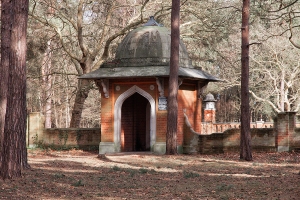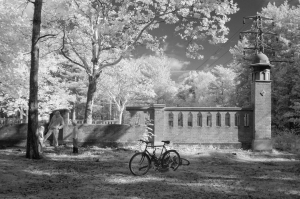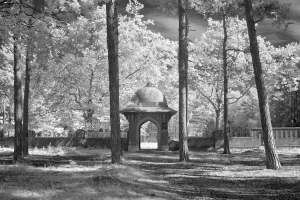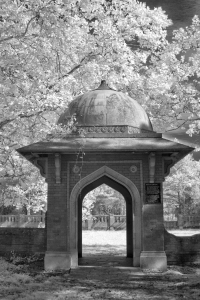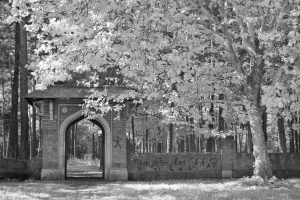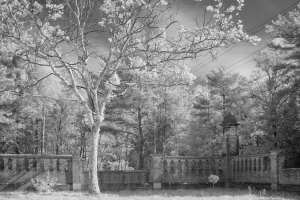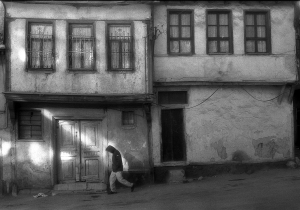Explorations with Infrared
3. Pylons
In the 1930s poets highlighted contrasts between the old and the new and conflicting values. Pylons became one of the symbols of this new order.
The secrets of these hills was stone, and cottages
Of that stone made
And crumbling roads
That turned on sudden hidden villages
Now over these small hills they have built the concrete
That trail black wire:
Pylons, those pillars
Bare like nude, giant girls that have no secret
The valley with its gilt and evening look
And the green chestnut
Of customary root
Are mocked dry like the parched bed of a brook
But far above and far as sight endures
Like whips of anger
With lightning’s danger
There runs the quick perspective of the future
This dwarfs our emerald country but its trek
So tall with prophecy
Dreaming of cities
Where often clouds shall lean their swan-white neck.
(Stephen Spender)
I commented in my previous post regarding the way in which infrared brought out the hard alien nature of the pylons against the softness of the leafy trees and bricks of the old burial ground. I thought that in some respects we’ve become so used to pylons that they’re just a part of the landscape as they march in regimented order. But maybe not!
Pylons have always interested me. – their shapes (French ones are very different); birds perching on the wires; men who risk death to repair/paint them . Pylons are dangerous in and of themselves – does it do harm if you live near to one? When I mentioned pylons to my daughter she said that there was a pylon on Chobham Common and when you walked past it you could hear it crackle! There was a short walk where we used to live where a pylon was standing right in front of a house .
I decided to look for more information on pylons. Concurrently I decided, again, to use both normal and infrared photography to explore how each of them might express my feelings regarding the way in which we become so used to having something in our midst that we almost forget it’s there. I haven’t forgotten about the Muslim Burial Ground though and will be returning to it later.
Following the Pylons
On a visit to the National Grid website I found a question asking whether information could be given on the location of pylons ‘under The Freedom of Information Act’. The answer was that pylons aren’t covered by the Act, presumably this is in the interests of protection against attack etc. I discovered that pylons are shown on ordnance survey maps but the distance between them is ‘representational’. This wasn’t a problem because I already knew were there were some nearby pylons.
First I went back to the burial ground where, amongst others, I took a photograph using my normal camera to match the IR one

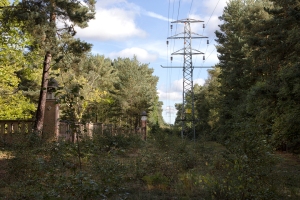
I also did two conversions on a colour photograph for further comparison
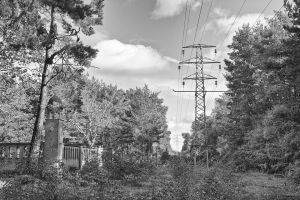
(converted to b+w in Photoshop CS5 (linear contrast) plus Nik Silver Efex Pro 2 full contrast and structure filter at 50% opacity.}
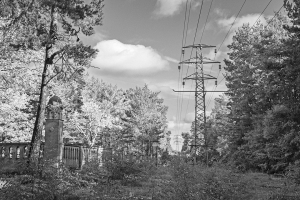
(converted to b+w with IR filter in Lightroom 4, plus linear contrast and sharpening in CS5.)
I think that here the IR filter in Lightroom 4 has the edge over the b+w and colour versions. If I’ve understand correctly then this is due to the fact that there is so much green foliage. In the colour version these greens merge together more whereas they become more distinct firstly in b+w and then with the Lightroom filter. In addition, the pylon also becomes more distinct.
Continuing along the pylon path
A recreation ground:-
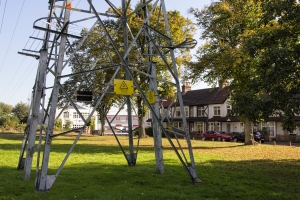
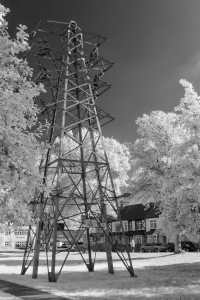
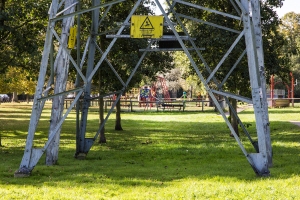


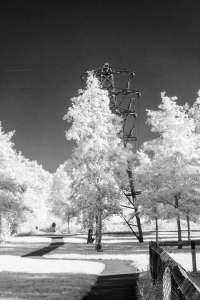
In the IR image the pylon looks more ethereal here whereas I think the colour images draw more attention to the dangerous aspect because of the yellow sign and the way I’ve composed to show the nearness to people passing by and the playground.
The line stretched further over the canal and then joined the burial ground. A few miles beyond and I found the overhead lines emerging at a golf course.
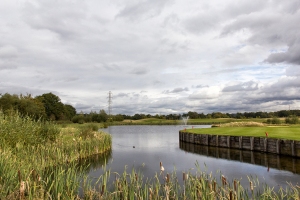
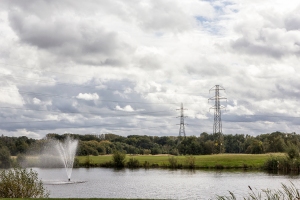
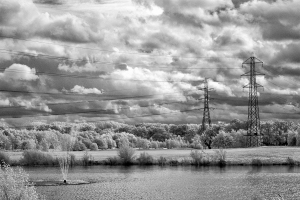
In this location I quickly became aware how I was being attracted towards the pylons; their architectural aspects and how they’d been designed into the landscaping. I’m guessing that they were there before the golf course was created. I was using them as a compositional aspect as opposed to a contrast in the theme.
Presenting them for discussion on the Brighton Study Weekend
I took some prints with me for the group review session and there was quite a discussion. I won’t go into it in depth us, in summary, there were comments from one of the tutors in terms of the IR images looking like an etching and being too pretty/chocolate boxey’. He seemed to prefer another idea of mine that was to follow the canal rather than the pylons. Some of my fellow students quite liked the IR images stating that there was nothing wrong with beautiful images. In comparing the two images of the lake, it was pointed out that, in the colour version the fountain caught the eye first, whereas, in the IR version, the pylons caught the eye first. There were suggestions that if I wanted to go the ironic/subversion route I could make the pylons look extremely pretty which could then make people start to interrogate them more closely. Another suggestion was to just carry on doing both and ‘follow the pylons’ to see where they led me in terms of appropriateness to what I wanted to convey. Paul Cabuts was a name given to me by the tutors as a photographer who had done a series on pylons (see below).
Some information I found regarding pylons
I have to admit that I did become somewhat obsessed with pylons and had to stop myself from talking too often about them. I’ll go into recovery when I’ve finished this post I think! There is a Pylon Appreciation Society and also quite a few groups on Flickr.
I found some references to the possible health risks of living near Pylons (and other structures which emit electrical fields) – dementia, leukemia and cancer have been referred to during the past ten years. This latest one quotes an American study . There’s a site here that gives latest news on planning proposals, dangers of overground pylons and how to make representations etc . I phoned our local planning department to ask what the regulations were concerning buildings and pylons and was directed to The National Grid which gives the advice. From the National Grid site I learned that there are no specific regulations in force. Advice is given on how to enable better quality development near power lines and there is a link to a PDF that can be downloaded (link below). I thought this made interesting reading particularly this quote:-
The current urban renaissance planning and design agenda promotes a compact urban form featuring a mix of uses and the efficient use of land through the use of higher density development. This leads to an intense built form with taller buildings, smaller gardens (front and back), and narrower streets employing more interlinked building forms than might have been considered in the recent past.
This dense urban form provides good opportunities to screen views of pylons and diminish their visual impact.
Reflections : Where do I stand at the moment with both pylons and infrared?
My original purpose was to construct a series of images that would show how pylons and people exist alongside each other to the extent that people accept them as part of the landscape. I think this does happen where pylons have been around for many years (our current pylon design dates back to the 1920s). Having read around this I’m reminded though that genuine concerns about the health risks do arise, and are researched, over the years and people do protest when new projects involving pylons (and other forms of overground transmission) are suggested. I certainly wouldn’t want to live near one.
I’m not sure at this stage that infrared can portray these tensions although, to me, it certainly brings out the differences between the man-made world and nature. If I knew that there was going to be a local protest and decided to photograph this would I use colour, b+w or infrared? Knowing me I’d probably prevaricate; decide to use a combination, and then decide afterwards what best portrayed the issue. Is this a cop-out? Well, it probably is so I’m going to have to do more thinking around this whole infrared topic.
In the meantime though I’ve looked at some other photographers and how they have photographed pylons.
Some photographers and some pylons
I looked at Paul Cabuts, Mark Power and Simon Roberts; contacted each of them to ask for permission to use their images and they all agreed. Paul Cabuts and Simon Roberts additionally emailed me a higher res photograph with some good luck wishes.
Paul Cabuts
Paul Cabuts’s website explains that his practice is grounded in the valleys of South Wales and that he was “initially motivated by the differences between his personal experiences of the living and working in the Valleys, and the way in which they had been represented in photography and other media”. His series ‘Powerlines (2002-2004)‘ “respond to (and echo) the highly positive images taken for the South Wales Electrical Power Distribution Company (SWEPD) in the 1920s”. When I first looked at them I thought of the Bechers and ‘typologies’. However, a closer look reveals the way in which he wanted to portray their individuality.

Cefn Gelligaer © Paul Cabuts
In a sense this reminds me of the way in which I gradually became drawn to the architecture and structure of the pylons I visited. Also I doubt that either b+w or colour would have been able to show the distinctive properties of the landscape that define the individuality of the poles.
Mark Power
Mark Power’s Project “26 Different Endings” (2003-2006) visited places that fall just off the edge of the pages of the A-Z London Street Atlas. He writes,
The coverage of the map changes with each new edition. Someone somewhere decides, year by year, where it should end; which parts of the periphery of London should be included, and which should not. This project is about the unfortunate places that fall just off the edge.
The 26 images in the series provide a wonderful serendipity that is held together by their special (non) place in the A-Z Atlas. One of them includes two pylons

T 128 South © Mark Power
Simon Roberts
Simon Roberts travelled across England in a motorhome between 2007 and 2008. He produced a portfolio “We English” http://simoncroberts.com/work/we-english/#PHOTO_0 – large-format tableaux photographs of the English at leisure. The description states:
Roberts aims to show a populace with a profound attachment to its local environment and homeland …. The resulting images are an intentionally lyrical rendering of a pastoral England, where Roberts finds beauty in the mundane and in the exploration of the relationship between people and place, and of our connections to the landscapes around us.
Again, there are a variety of images all held together by the theme. I hadn’t seen the following image before I began my own series but it shows exactly what I wanted to portray – it’s just that I haven’t quite got there yet, although at least I have a guide.
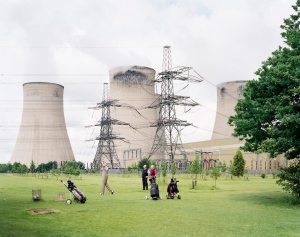
http://simoncroberts.com/work/we-english/#PHOTO_29 (c) Simon Roberts
Conclusion
I know I have to do yet more thinking around infrared and its uses to achieve the moods, reflections, and themes etc I hope to portray. It’s been very interesting to explore and compare infrared, b+w and colour along my journey so far. I’ve surprised myself about my relationship with pylons – the fascination they hold for me; the way I became just about obsessed with them, and how I moved from wanting to exclude them from compositions in the past (because they weren’t ‘attractive’) towards seeing their structure and architecture in compositional terms and accepting them as part of the landscape. I’ve spent several weeks thinking, reading and photographing them to the extent that I’m now late in producing my next assignment!
I looked at other photographs afterwards. Yes – they could have informed my own work but, in a way, I’m pleased I just went ahead. I do have more in my photography armoury now though. Paul Cabuts’s work is an excellent example of using pylons or other structures as subjects in themselves – having their own individual characteristics as brought out by their locations. In the series by Mark Power and Simon Roberts the pylons play a part of the composition. In Mark Power’s image the pylons are intrinsic to both the scene and the composition. He chose to include them and, of course, he could have excluded them and produce a different image. In Simon Roberts’s photograph the cooling towers and pylons play an important backdrop to the whole scene and add to the wry look at how the English can be so absorbed in their leisure pursuit that they are (probably) oblivious to whatever else is around them.
12th December 2012
References
Photographers
http://www.markpower.co.uk/projects/26-DIFFERENT-ENDINGS
http://www.paulcabuts.com/gallery.html
http://www.paulcabuts.com/gallery_252144.html
http://simonroberts.com
http://simoncroberts.com/work/we-english/#PHOTO_0
Planning permission and pylons
http://www.emfs.info/Related+Issues/property/UK/design/
http://www.emfs.info/Related+Issues/SAGE/first/corridorwidth.htm
http://www.dailymail.co.uk/sciencetech/article-2049258/New-electricity-pylons-T-shaped.html
http://www.independent.co.uk/news/electricity-pylons-pose-health-risk-1167517.html
http://www.nationalgrid.com/uk/senseofplace
http://www.nationalgrid.com/NR/rdonlyres/98636F39-F2AF-4D9B-9D9E-A1366AB73B8A/1154/ASopCreatingDesignGuidelines.pdf
http://www.no-moor-pylons.co.uk/Latest%20News.html
http://www.telegraph.co.uk/earth/earthnews/3344158/Nuclear-plans-could-mean-miles-of-giant-pylons.html
























